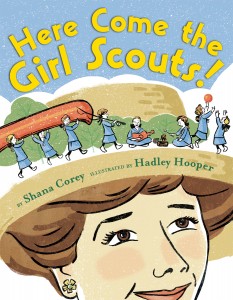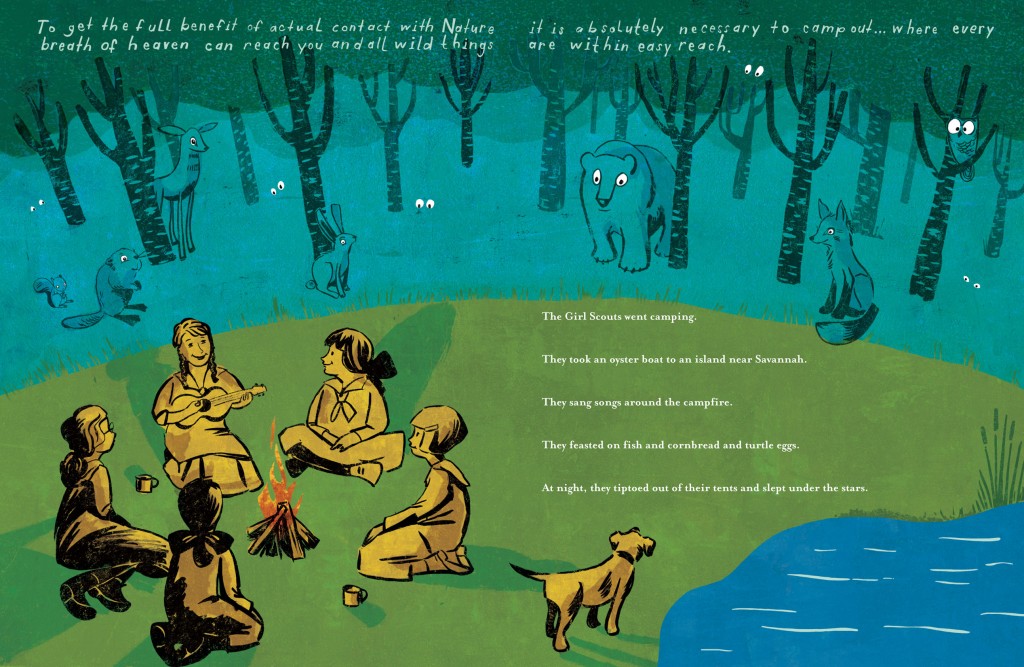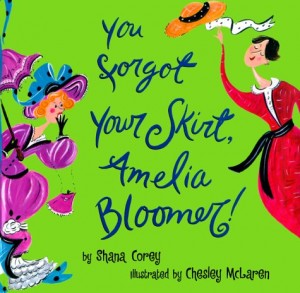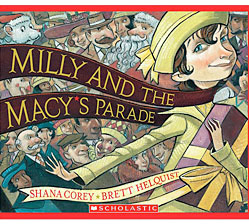By Nicki Richesin, The Children’s Book Review
Published: February 17, 2012

Shana Corey is one remarkable lady. She’s an author of many bestselling books; editor at Random House Books for Young Readers; and mother to two young boys in Brooklyn. Her biographies on extraordinary women include Mermaid Queen: The Spectacular True Story of Annette Kellerman, who Swam her Way to Fame, Fortune & Swimsuit History!, You Forgot Your Skirt: Amelia Bloomer!, and Players in Pigtails. Her most recent book is a tribute to the founder of the Girl Scouts, Juliette Gordon Low. Tagalong (get it?) with us as we discuss books, writing, and fascinating women in history.
Nicki Richesin: Congratulations on the wonderful reviews for Here Come the Girl Scouts! You were inspired to write this book by your mother’s Girl Scouts stories growing up in Savannah, Georgia. You’ve written about many women who were ahead of their time. What makes Juliette “Daisy” Gordon Low especially appealing to you as a role model for young readers?
 Shana Corey: Thank you! I think she’s a great role model for so many reasons—she was an early advocate for both conservationism and exercise for girls, she encouraged girls to be financially independent and to make a difference in the world (something she was passionate about doing herself). But perhaps even more, I admire her personality. Juliette Gordon Low was someone who walked to the beat of her own drummer and made no apologies for that. I think that’s something we should all aspire too!
Shana Corey: Thank you! I think she’s a great role model for so many reasons—she was an early advocate for both conservationism and exercise for girls, she encouraged girls to be financially independent and to make a difference in the world (something she was passionate about doing herself). But perhaps even more, I admire her personality. Juliette Gordon Low was someone who walked to the beat of her own drummer and made no apologies for that. I think that’s something we should all aspire too!
I also loved that she turned what could be considered a weakness (her deafness) into an advantage. When she was fundraising and looking for volunteers for Girl Scouts, if someone declined she’d literally pretend she hadn’t heard them and say “Wonderful! I’ll put you down for next week.” She was very determined and went about things in exactly her own way.
And of course, I’m in awe of her legacy. The organization she founded has been empowering women for 100 years now. Over 50 MILLION women have been Girl Scouts. Talk about making a difference!

NR: When writing a children’s picture book biography, how do you find that part of someone’s personal story that will connect with a reader? Do you discover it while you’re doing research or while writing the book?
SC: Great question! A little of both. I usually get a lot of ideas while I’m researching and I’m constantly jotting down things that I think might work as themes or overarching threads (I don’t want the book to read like just a series of anecdotes-I want there to be a through thread that connects everything and gives it a structure). But after researching I usually have way too much to include in a 32 or 40 page picture book, so a lot gets cut or moved to the Author’s Note and I try to hone in on the core-the personal story that makes the book relevant to a 7 year old. For instance, Daisy suffered through a very painful marriage and it was in going through that that she began to feel useless and started searching for a way to make a difference in the world. The painful marriage has no meaning for a child though, so that ended up in the author’s note. In the story, I focused on her love of adventure and the outdoors—which was also key to her personality, and is directly related to the Girl Scouts focus on getting outside and is also more relevant to kids.
NR: Your love of women’s history and “olden day” heroines like Laura Ingalls Wilder led you to create books about lesser known women who achieved greatness within their lifetimes. I think it’s funny that prevailing attitudes about decency and undergarments happens to be a common theme between You Forgot Your Skirt: Amelia Bloomer! and Mermaid Queen: The Spectacular True Story of Annette Kellerman, who Swam her Way to Fame, Fortune & Swimsuit History! Did you find that clothing was something a modern audience could relate to and provide a window to the past?
 SC: Absolutely. I actually learned about Annette Kellerman in a footnote when I was researching Amelia Bloomer and so I see those books as a pair. And yes, I do see clothes as something that can connect kids to the past. As a kid, I loved playing dress up. Putting on the clothes allows you to really imagine what it would be like to be someone else and I think that (and other every day things like food) are a very accessible entry point into history.
SC: Absolutely. I actually learned about Annette Kellerman in a footnote when I was researching Amelia Bloomer and so I see those books as a pair. And yes, I do see clothes as something that can connect kids to the past. As a kid, I loved playing dress up. Putting on the clothes allows you to really imagine what it would be like to be someone else and I think that (and other every day things like food) are a very accessible entry point into history.
NR: I understand you spent time with Jan and Stan Berenstain at Random House and listened to their stories. What fun! Would you be willing to share a story you heard with our TCBR readers?
SC: Sure! I’ve had the great fortune of working at Random House Books for Young Readers since just after I graduated from college and have been starstruck on many, many occasions (I still get starstruck!). When I was an editorial assistant our publisher, Kate Klimo, very kindly invited me to go with her and our art director (the legendary Cathy Goldsmith, who worked with Dr. Seuss among other kids book luminaries) to a meeting with Stan and Jan Berenstain (which happened to be at their house!) It was a surreal day. Before we headed back to New York, Jan offered to sign a book for me and asked which one I’d like. I had a very clear memory of my mom getting The Berenstain Bears Go to School to prep me for kindergarten-and it was such a neat moment for them to pull a copy of that same book from their personal bookshelf and sign it for me!
I’m not sure if I heard this particular story that day or later, but one of the Dr. Seuss stories that’s stuck with me is that apparently, he never asked for a contract or an advance before he finished a project. In fact, he wouldn’t even tell anyone he was working on something, he’d just show up with a finished or almost finished book.
NR: Your grandparents’ immigrant stories for their traditions in the old country inspired you to write Milly and the Macy’s Parade. Could you tell us how you invented this story?
 SC: I read that the Macy’s Thanksgiving Parade was originally called the Macys Christmas Parade and was begun in the 1920s by immigrants who worked at Macys and who were homesick for the holiday traditions of their homelands. That made me think of my own grandparents who were first generation American children in the 1920s. I started wondering who actually came up with the idea for the parade (I did some research-but no one really knows who had that first idea), and I imagined what it would have been like if it began with the child of one of those homesick immigrant employees, a little girl who would have been exactly my grandmother’s age in 1924 and who was trying to cheer her parents up and help them to adjust to their new life in America.
SC: I read that the Macy’s Thanksgiving Parade was originally called the Macys Christmas Parade and was begun in the 1920s by immigrants who worked at Macys and who were homesick for the holiday traditions of their homelands. That made me think of my own grandparents who were first generation American children in the 1920s. I started wondering who actually came up with the idea for the parade (I did some research-but no one really knows who had that first idea), and I imagined what it would have been like if it began with the child of one of those homesick immigrant employees, a little girl who would have been exactly my grandmother’s age in 1924 and who was trying to cheer her parents up and help them to adjust to their new life in America.
I have a very clear memory of the first time I visited New York City and Macys as a young teenager. It’s so incredibly ornate and gilded inside—I thought it was the fanciest thing I’d ever seen. And I thought if it was that impressive to me, a 1980s kid who was used to TV and malls and glittery things, then it must have been absolutely magical to a child living in a New York tenement in the 1920s.
NR: What’s your favorite part about doing research on your characters?
SC: I love (love, love) reading old newspaper articles and ads-I get lost in them.
NR: As an editor at Random House, what do you look for in a possible project that would inspire you to commit to championing it in-house? Have you ever lost a project that you felt you could have promoted to great fanfare?
SC: My editing focus is middle grade and YA and I’m a sucker for voice. I think a strong, clear voice can make a story transcend the specifics of the plot and feel universal, and if I fall in love with a voice, I’ll follow a character anywhere. Jennifer L. Holm is someone I think is an absolute master of voice. Read Penny From Heaven or Turtle in Paradise and those characters will stay with you for the rest of your life.
And yes, I have lost projects. It’s hard, but it’s part of being an editor‑sometimes you don’t win the auctions. What I think harder is having to pass on things for other reasons. For instance if something comes in at a time when I’m just too busy with other deadlines to give it the time it needs at that moment and so I have to pass or pass it to another editor. And then invariably, I surface a month or so later and I can’t believe I let it go!
NR: Which historical figures (or lesser known ones) would you like to write about next? Are there books you’re yearning to write that you feel would be hard to find an audience for?
SC: Right now I’m working on a book about the history of the New York City subway, which has been fascinating and involves reading lots of old newspaper articles about how disgusting and garbage filled New York City’s streets were in the 19th century. (I used to wish I lived two hundred years ago, one thing research has taught me is that I definitely don’t!).
And there are so many people I’d like to write about! I’d love to write about Leonardo DaVinci one day. And I’ve been toying with writing about Albert Einstein for years but haven’t hit on the right story to tell about him yet. Every time I start to research, I get stuck on the math. If I can’t understand it, there’s no way I can make it work for kids.
NR: As the mother to two little boys, do you ever feel compelled to look for stories about male role models to tell them? Which of your books are their favorites?
SC: I do and I also think there are a lot of wonderful stories already out there. One of my kids’ favorites is George Washington and the General’s Dog, an early reader by Frank Murphy (disclaimer-I edited this one—but it’s so good! I’m really proud to have worked on it). It shows a human side of George Washington I’d never heard of before—his love for animals—and has given my kids a real appreciation for George Washington not just as a historic figure, but as a living, breathing person they could imagine being friends with. Ben Franklin and the Magic Squares also by Frank Murphy is another of my kids’ favorites, as is Abe Lincoln Crosses a Creek by Deborah Hopkinson. And The Man Who Walked Between the Towers by Mordicai Gerstein is one they ask for again and again (and it’s absolutely beautiful and brilliant and perfect).
For my books, they’re really sweet, supportive kids so they’ll say whatever I’m working on now is their favorite. They’re excited about the subway book because we’re big fans of the New York City transit museum. They’re also partial to an early reader I wrote, Barack Obama: Out of Many, One—because they’re extras in one of the illustrations.
NR: I have to ask this, what’s your favorite type of Girl Scout cookie?
SC: Thin mints, of course!
NR: Thank you so much for your time!
Thank you for having me, it’s been a pleasure! (And if you know any Girl Scouts, I’m offering free bookplates and skype visits to schools and Girl Scout troops who are reading Here Come the Girl Scouts! this spring-come visit me at www.shanacorey.com if you’d like one-or just to say hello!)
Nicki Richesin is the editor of four anthologies,What I Would Tell Her: 28 Devoted Dads on Bringing Up, Holding On To, and Letting Go of Their Daughters; Because I Love Her: 34 Women Writers Reflect on the Mother-Daughter Bond; Crush: 26 Real-Life Tales of First Love; and The May Queen: Women on Life, Work, and Pulling it all Together in your Thirties. Her anthologies have been excerpted and praised in The New York Times, the San Francisco Chronicle, The Boston Globe, Redbook, Parenting, Cosmopolitan, Bust, Daily Candy, and Babble.
